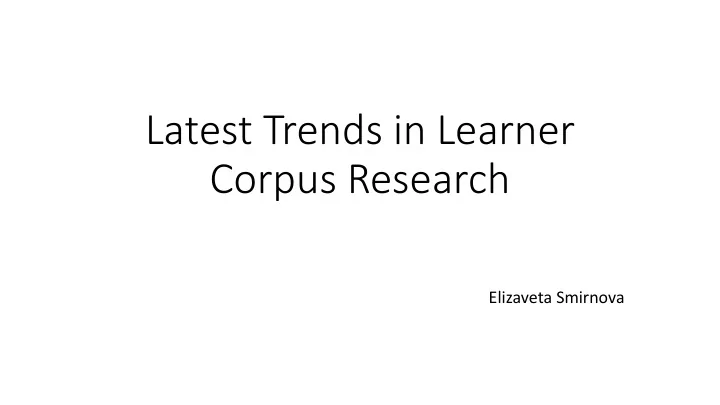

Latest Trends in Learner Corpus Research Elizaveta Smirnova
Plan • Literature • Objects of research • Approaches to complexity assessment • Data • Methods • Recommendations
Literature • Works on LCR published over the last five years • Mainly authored by scholars from the Centre for English Corpus Linguistics (CECL), Belgium • See References
Objects of Research • Multiword units typical of academic language (Granger, 2017) • Lexical bundles (Huang, 2015) • Subject-specific markers (Flowerdew, 2019)
Approaches to Complexity Assessment • assessment of formulaic sequences in learner texts : a technique that assigns to each pair of contiguous words in a learner text two association scores (mutual information and t-score) computed on the basis of a large native speaker reference corpus. • “Correlation and hierarchical regression analyses, conducted on two datasets of English- as -a-foreign-language texts, showed that formulaic measures were the best predictors of text quality and provided a much higher specific contribution to the prediction than single-word lexical measures of diversity and sophistication” (Bestgen, 2017).
Approaches to Complexity Assessment (2) However • sentence length • TTR and • MTLD (Measure of Textual Lexical Diversity) are still used to assess L2 proficiency (Bulon et al., 2017) There is today an urgent need for more text-based or internal methods to assess proficiency level in LCR (Paquot & Plonsky, 2017).
Data • Most LC studies focus on written corpora, spoken data are explored in a third of works a small number of studies (about 3%) analysed both (Paquot & Plonsky, 2017) • There is a trend to analyse LC without any reference corpus, i.e. without comparing results with corpus data sampled from native/expert speakers (Paquot & Plonsky, 2017) • Diachronic approach: learner language across different years of study (Flowerdew, 2019)
Methods • Relevant shortcomings of LCR as reported by Paquot and Plonsky (2017): • Corpus linguists often report results for complete (sub-)corpora and rarely inspect by-speaker or by-text results (Brezina & Meyerhoff 2014; Gries 2006a). • Corpus linguists rarely provide information concerning dispersion as a supplement to frequency data (e.g. Baayen 2001; Gries 2014). • Corpus linguists often fail to report whether the assumptions of statistical tests have been checked and met (Baroni & Evert 2008; Köhler 2013; Gries 2015b).
Methods (2) • Chi-square and log-likelihood are considered to be not valid for description of lexical variations between corpora as they produce too many significant results. The author proposes using an easy procedure in R to perform the significance tests (Bestgen, 2017) • R, alongside with AntConc and Coh-Metrix, is currently gaining popularity among LC researchers with WordSmith Tools being used most frequently (Paquot & Plonsky, 2017).
Recommendations (Paquot & Plonsky, 2017) 1. Substantive areas in need of further attention are Pragmatics and Pronunciation 2 Investigate a greater variety of learner production (i.e. speech in its various forms, more varied genres and tasks). 3 Resort to text-based methods to assess proficiency. 4 Carry out more cross-sectional and longitudinal studies. 5 Check the assumptions of statistical tests. 6. Conduct fewer tests of statistical significance and correct for the alpha level. Be skeptical of p values.
Recommendations (2) 7 Consider multivariate statistics 8 Formulate research questions 9 Identify each software tool used, report the settings employed, and describe each methodological step. 10 Report precision and recall rates for any automatic annotation tool (e.g. POS-tagger, parser) used. 11 Report more thoroughly descriptive statistics, including standard deviations with all means.
References • Granger, S. (2017). Academic phraseology: A key ingredient in successful L2 academic literacy. Oslo Studies in Language , 9 (3) • Bestgen, Y. (2017). Beyond single-word measures: L2 writing assessment, lexical richness and formulaic competence. System , 69 , 65-78 • Bulon, A., Hendrikx, I., Meunier, F., & Van Goethem, K. (2017). Using global complexity measures to assess second language proficiency: Comparing CLIL and non-CLIL learners of English and Dutch in French-speaking Belgium. Travaux du CBL 11 (1) , 1-25. • Bestgen, Y. (2017). Getting rid of the Chi-square and Log-likelihood tests for analysing vocabulary differences between corpora. Quaderns de Filologia-Estudis Lingüístics , 22 (22), 33-56. • Paquot, M., & Plonsky, L. (2017). Quantitative research methods and study quality in learner corpus research. International Journal of Learner Corpus Research , 3 (1), 61-94. • Brezina, V. (2018). Statistics in corpus linguistics: A practical guide . Cambridge University Press. (can share the book) • Huang, K. (2015). More does not mean better: Frequency and accuracy analysis of lexical bundles in Chinese EFL learners' essay writing. System , 53 , 13-23. • Flowerdew, L. (2019). English as a lingua franca and learner English in disciplinary writing. Specialised English: New Directions in ESP and EAP Research and Practice .
Recommend
More recommend